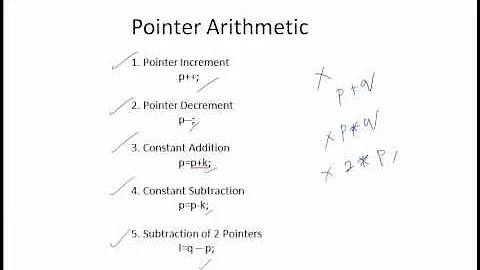Pointer arithmetic for structs
Solution 1
struct foobar *p;
p = 0x1000;
p++;
is the same as
struct foobar *p;
p = 0x1000 + sizeof(struct foobar);
Solution 2
The answer is that it is at least
sizeof(double) + (3*sizeof(int))
Thew reason it's "at least" is that the compiler is more or less free to add padding as needed by the underlying architecture to make it suit alignment constraints.
Let's say, for example, that you have a machine with a 64-bit word, like an old CDC machine. (Hell, some of them had 60-bit words, so it would get weirder yet.) Further assume that on that machine, sizeof(double) is 64 bits, while sizeof(int) is 16 bits. The compiler might then lay out your struct as
| double | int | int | int | 16 bits padding |
so that the whole struct could be passed through the machine in 2 memory references, with no shifting or messing about needed. In that case, sizeof(yourstruct_s) would be 16, where
sizeof(double)+ (3*sizeof(int)) is only 48 14.
Update
Observe this could be true on a 32-bit machine as well: then you might need padding to fit it into three words. I don't know of a modern machine that doesn't address down to the byte, so it may be hard to find an example now, but a bunch of older architectures ould need this.
Solution 3
Pointer arithmetic is done in units of the size of the pointer type.
So if you do p++ on a pointer to your struct, p will advance by sizeof *p bytes. i.e. just ask your compiler for how big your struct is with the sizeof operator.
Solution 4
p = p + sizeof(YourStruct)
The compiler is free to decide what sizeof will return if you don't turn padding off.
Related videos on Youtube
user950891
Updated on February 05, 2020Comments
-
user950891 over 4 years
Given a struct definition that contains one double and three int variables (4 variables in all), if p is a pointer to this struct with a value 0x1000, what value does p++ have?
This is not a homework problem, so don't worry. I'm just trying to prepare for a test and I can't figure out this practice problem. Thanks
This is in C. Yes I want the value of p after it is incremented. This is a 32-bit machine
-
 Admin over 12 yearsThe result of
Admin over 12 yearsThe result ofp = 0x1000, p++is0x1000as post-increment results in the old value. Is this a trick question or did you mean to ask for the value ofpafterp++= the result of++p= the result ofp + 1? -
cHao over 12 yearsAside from all that, and assuming what you really wanted was the new value of
p, and that this is C or C++ (since very few other languages have all of pointers,struct, andint), the answer is dependent on the size of the struct's members, which is implementation-defined. Nothing says an int has to be 4 bytes; sometimes it's 2, sometimes 8, sometimes some other size altogether. -
Radu over 12 yearsMy immediate guess would be that it is incremented by 4 bytes on 32b systems and 8 bytes on 64b.
-
cHao over 12 years@Radu: your guess would be wrong -- if
pis amystruct *, then incrementing it addssizeof(mystruct)to the address. -
visual_learner over 12 years@Radu - Really? On my 32-bit system, an
intis 4 bytes and adoubleis 8, so 4 bytes isn't enough to put it past the first variable. -
Radu over 12 yearsSorry, was thinking of an array of pointers to the structure.
-
-
visual_learner over 12 yearsYou should add a cast to
char *to make it clearer that you're doing byte-level pointer arithmetic rather than C-level pointer arithmetic. -
 nos over 12 yearsNote that compilers generally will add padding such that the struct members is suitable aligned when you make an array of your struct. if the first member here is a double, it'll be aligned such that all elements in an array of that struct start at an address suitably aligned for doubles. (and there might be padding added for the other elements as well so they end up nicely on an address according to their type)
nos over 12 yearsNote that compilers generally will add padding such that the struct members is suitable aligned when you make an array of your struct. if the first member here is a double, it'll be aligned such that all elements in an array of that struct start at an address suitably aligned for doubles. (and there might be padding added for the other elements as well so they end up nicely on an address according to their type) -
 Charlie Martin over 12 years@ChrisLutz I'm a mathematician, not an accountant. You're right of course.
Charlie Martin over 12 years@ChrisLutz I'm a mathematician, not an accountant. You're right of course.







![Pointers in C / C++ [Full Course]](https://i.ytimg.com/vi/zuegQmMdy8M/hq720.jpg?sqp=-oaymwEcCNAFEJQDSFXyq4qpAw4IARUAAIhCGAFwAcABBg==&rs=AOn4CLB4u7IlBRMOT2ye9vhQmBTYtpjRPg)